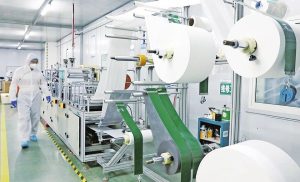
The main component of limestone is calcium carbonate, which after processing becomes our common quicklime and slaked lime. Limestone is mainly divided into five categories. Limestone with different properties has different uses. It is an indispensable raw material in various sectors of the national economy and people’s lives.
Limestone use:
1. Used in the construction industry to produce cement and burnt lime
2. Used as flux in metallurgical industry
3. Used in the chemical industry to make alkali, bleaching powder and fertilizer, etc.
4. Used as clarifier in food industry
5. Used to improve soil in agriculture
6. Used as a filler in the plastics industry
7. Widely used in various architectural coatings in the coating industry
8. Used as alkaline filler in paper industry
9. Used as the basic filler of rubber in the rubber industry
10. Used as adsorbent in environmental protection industry
Application of heavy calcium in non-woven fabrics:
The main material used in the production of masks is non-woven fabric
One of the most important raw materials for the production of non-woven fabrics is heavy calcium carbonate powder.
The main materials for the production of protective clothing are plastic, breathable film, etc.
One of the important materials for the production of plastics and breathable membranes is heavy calcium carbonate powder.
The PP filler masterbatch made of calcium carbonate is widely used in the non-woven fabric industry. As an important raw material for mask accessories, it has a better application prospect after experiencing the epidemic, which has driven the increase in the use of calcium carbonate in the non-woven fabric field. .
What is non-woven fabric?
Non-woven fabrics should actually be called non-woven fabrics, or non-woven fabrics. According to the European Disposable Products and Nonwovens Association (EDANA), the world’s most important and authoritative nonwovens organization, nonwovens should be defined as fibers, filaments or treated fibers that can form a network, and can Materials that are bonded together are nonwovens and do not include woven, woven or knitted fabrics. Almost all nonwovens are technical textiles. Nonwovens have broken through the traditional textile principles, and have the characteristics of short process flow, fast production speed, high output, low cost, wide application, and multiple sources of raw materials.
Infant care products (diapers, growing pants, urine pads, wet wipes); feminine hygiene products (pads, sanitary napkins); adult care products (diapers, urine pads) are the main application areas of non-woven fabrics. In addition, non-woven fabrics can also be used in the medical market (surgical gowns, sterile quilts, sterilization bags), construction markets (including door/window covers, house insulation, roof materials and geotextiles), industrial or industrial special markets, and Filtration and home improvement fields.
